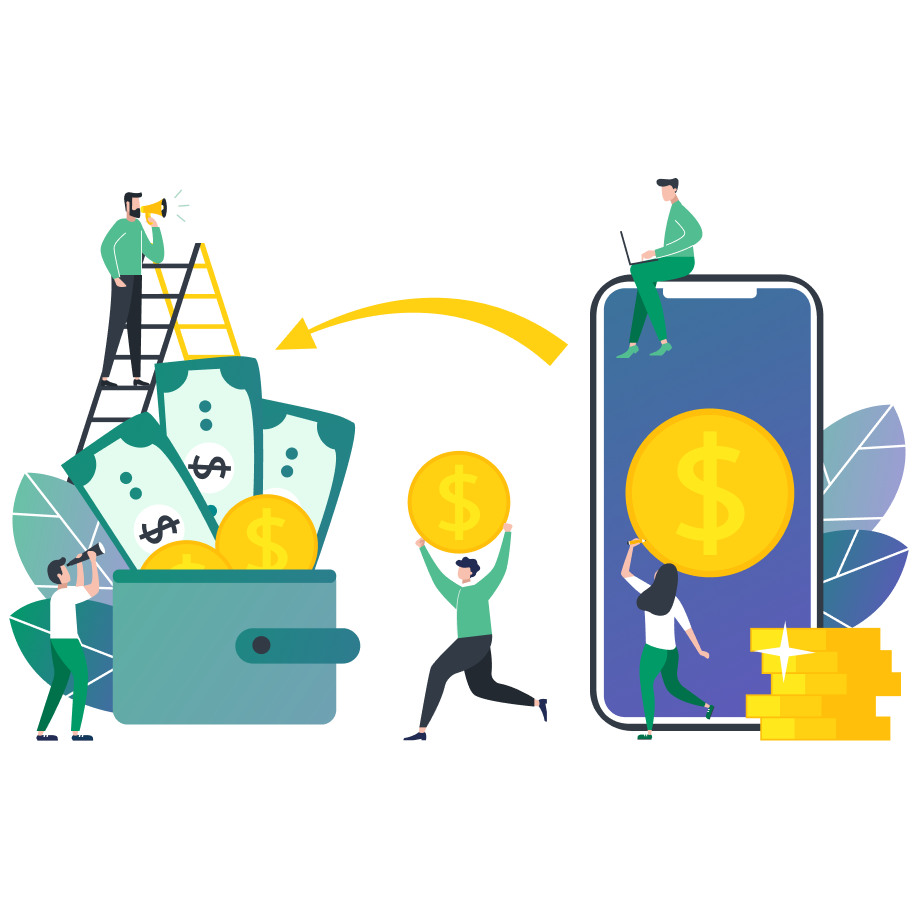BrainTek: Guiding Clients from the Ground Up to Make Faster Mobile Transactions
SERVICES USED:
SERVICES USED:
The Challenge
The founders of MJDS, BrainTek, Meddy Abeid, and Tilak Patel, hoped to recreate a system implemented in other African countries in an effort to simplify and facilitate easier transactions between customers and merchants in Tanzania.
The Solution
A team at Softjourn designed the MOJA project to work on the mobile wallet system connected to a telecom provider, just as the current system does. This also allows users to continue to use their phones to manage and maintain their mobile accounts.
The Benefits
- easy registration
- fast communication with POS devices
- focus on seamless user experience
The Challenge
An extensive rural population and sporadic internet availability have resulted in a lack of banking structure in Africa. Instead, the continent has emerged as a global leader in mobile money transactions.
These transactions are an important component of Africa’s financial services infrastructure, as without it, the exchange of goods and services for currency would be vastly hindered.
In terms of mobile money transactions, Tanzania follows but exceeds the trends of overall adoption. Almost 56 percent of Tanzanians are financially included, and almost 55 percent through mobile money accounts.
As it currently stands, a majority of the Tanzanian population makes purchases via Unstructured Supplementary Service Data (USSD)-based text using a mobile phone and a mobile wallet that is managed by telecom providers.
However, these transactions are subject to several fees controlled solely by the provider. In addition, the incompatibility of some merchants with different telecom providers, as well as user error, can introduce obstacles that can make money exchange and purchases difficult, if not impossible.
The current system also requires users to put money on a mobile account with one merchant before they can pay another, creating a several-step process before transactions are completed.
Enter the founders of MJDS BrainTek, Meddy Abeid and Tilak Patel, who hoped to recreate a system implemented in other African countries in an effort to simplify and facilitate easier transactions between customers and merchants in Tanzania.
They wanted to identify a way for people to reduce the extraneous steps and fees, implement direct pay, and create a closed-loop payment system.
In order to get a solid understanding of how such a system might work in Tanzania, BrainTek turned to Softjourn as an industry expert.

Making Transactions Easier
Currently in Tanzania, and many other areas in Africa, to purchase an item from a merchant, a customer sends a USSD-based text from a cell phone. Because the transaction is cashless, money for both sides of a transaction are stored in mobile phone wallets through one of Tanzania’s telecom providers.
This leaves both buyers and sellers exposed to a host of issues. Telecom providers can and do charge both transaction participants a fee, which can quickly add up.
In addition, much of the process relies on number codes. Users check their balance via a special number combination, and merchants also have special codes that buyers must use during the checkout process.
To shop, a buyer must dial the merchant’s phone number and then a special code, confirm the action, provide the amount, and confirm the purchase. This creates several opportunities for mistyping errors, possibly voiding a transaction, or worse, sending money to an incorrect party. The entire process is also quite time-consuming.
In addition, just over half of the 282 mobile money services operating worldwide are located in Sub-Saharan Africa.3 This means there are several different providers operating within Tanzania that don’t always “talk” to each other, resulting in incompatibility problems between providers.
The Solution
After witnessing a better solution in some areas of Africa, which both removed obstacles and ensured transactions were completed correctly, quickly, and more securely, BrainTek leveraged Softjourn’s experience to do the initial groundwork.
We did not want to be in a position where we started development and then got to a point where we should have defined something upfront and did not know where or how to go forward, said BrainTek CEO Meddy Abeid about the decision to partner with Softjourn.
Softjourn is a third-party software development resource that businesses use to develop new applications and systems from the ground up. It offers nearly two decades of virtual software development experience to clients in the US and Europe, handling the work from its development hubs in Ukraine, Poland, and Brazil and workforce in more than 30 countries worldwide.
These two entrepreneurs had an idea, and they wanted to explore more in detail how realistically it could work. They worked with Softjourn to define how all the different players would work within the system, how money was going to be transferred between the different parties, and how money and accounts were going to be settled, says Softjourn CEO and COO Emmy Gengler.
At the end of the project, Softjourn presented the requirements for the development of a system it calls MOJA, which means ‘one’ in Tanzania’s Swahili language.
Blueprints for a Better System
A study by Research ICT Africa4 found that 46 percent of urban dwellers and 86 percent of rural dwellers in Tanzania remain unconnected to the internet. Of those that are connected, it’s generally through the use of smartphones.
Because of this, Softjourn designed MOJA to work on the mobile wallet system connected to a telecom provider, just as the current system does. This also allows users to continue to use their phones to manage and maintain their mobile accounts.
However, MOJA relies on radio-frequency identification (RFID) devices, a point-of-sale (POS) terminal, and mobile apps for both to complete transactions. This will, ultimately, remove telecom providers from every step of a purchase, limiting burdensome fees. In addition, it would allow transfers between several different providers. And because there are no numbers to type, it helps to eliminate user error. MOJA requires that customers be issued RFID devices, which, for example, can take the form of a card or wristband that is programmed and linked to the processing server. For merchants, it requires a POS system set up by MOJA officials.
To register, both a customer and a merchant have to provide valid identification, including national/business ID numbers. All information is verified by a MOJA administrator. As part of the registration process, login credentials and a security question are also required to provide an extra layer of account security. Once set up, customers and merchants can use the login to access their mobile wallet account.
To make and complete a purchase, the system works very much like credit card systems. The total price of a transaction is entered on a POS device.
Then the user presents their RFID device (in this case, taps it on the POS device) to initiate payment, and the backend processes validate the transaction.
Because MOJA still needs to access a mobile wallet account, its server will communicate with the mobile provider via a specially designed API.
MOJA is designed to be USSD-based if an internet connection isn’t present, so it can work with both smartphones and non-connected cell phones.
In the MOJA system, only merchants are charged processing fees, though telecom provider fees still apply for any mobile banking account transactions.
All the money accumulated during the week from purchases will be stored in the MOJA system. Once a week, MOJA administrators forward merchants the total amount of all purchases made at their store during that week and withdraw the amount of fees the merchant owes MOJA and the telecom provider.
In addition, the system includes a smartphone application, which allows customers and merchants to manage their accounts, see transaction history, access reports, and much more.
The MOJA Transaction Process
- Merchant enters the total price of all items purchased on the POS device.
- The customer taps with the card or wristband.
- POS device sends the request to the Processing Server to check the customer’s authorization.
- The Processing Server verifies the RFID details to confirm that this customer is registered in the database.
- If not successful, the error notification is displayed on the POS device.
- If the information is valid, the Processing Server requests to run the transaction through the API to the Telecom Operator.
- Telecom Operator validates the data received (for example, if there is enough money in the account and if the number to which the funds will be transferred is valid).
- If the data is valid, the Telecom Operator requests the confirmation of the sender’s intent to purchase an item.
- The confirmation flow varies depending on the Telecom Operator.
- Telecom Operator receives confirmation, and it is being processed.
- If the data is valid, the Telecom Operator approves the transaction.
- Telecom Operator transfers money and returns a response about the performed transaction to the Processing Server.
- The Processing Server sends a successful message to the POS device.
- The POS device displays the transaction status (success/fail).
- The customer/merchant gets an SMS confirmation from the Telecom Operator regarding the transaction.
- The transaction record is saved to the customer/merchant mobile application in the Transaction History menu option.

The Result - Guiding Clients from Concept to Implementation
While creating the blueprint for MOJA was part of the project, it was only a part of the custom service that Softjourn provided to BrainTek.
Softjourn specializes in helping its clients take a concept through to completion. From consulting on start-ups to building out an entire blockchain system, the company is a valuable partner for those who use its services.
In the case of BrainTek, Softjourn representatives guided the founders through the MOJA blueprint, from the initial idea to how it would work in real life, as well as how BrainTek could make money as the facilitating company.
We walked them through the entire process, with all of the users from beginning to end, to be able to define that entire flow. They went from an idea and concept, which they had seen working from the outside, to now having a full understanding of how it works front end and back end, said Gengler.
Because the clients in this case did not come from the financial industry, Softjourn also brought in a payments consultant as part of the process to assess what they did and did not know and how the concept would work. It also created and handed off the documentation and blueprints of the MOJA system so BrainTek could show them to potential investors and pitch the idea to mobile phone companies.
Softjourn guides you through your journey in baby steps until you reach that pinnacle stage where you can actually go to the real world with your idea, said Abeid. Without them, it would have taken a quite a bit of time to get where we are right now.
Partnership & Recognition






